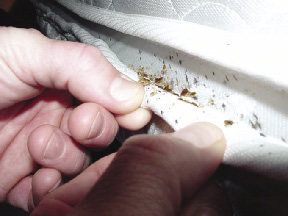For most people today, the phrase "don't let the bedbugs bite" is just a saying. Most of us have never even seen a bed bug. Even experienced pest professionals would be hard pressed to recall seeing this pest until recently. But for commercial property managers handling multi-unit residential buildings, a bedbug infestation can be a nightmare.
Bedbugs are making a very real comeback in the U.S., according to the pest professionals at Watch All Pest Control. Now, for the first time since the 1950s, we are seeing bedbugs in homes, apartments, motels, hotels, dorms, shelters and public transportation. The ease and frequency of international travel has undoubtedly played a role in the bedbug resurgence.
What are Bed Bugs?
About ¼ inch long, bedbugs are small, brown, oval, flattened insects that feed on animal and human blood. Cimex lectularius (the common bedbug) is quite well adapted to living with humans and has done so since ancient times. Primarily a nocturnal pest, the bedbug can fit in tiny crevices of mattresses, box springs, bed frames and headboards. They have even been found in electrical outlets, alarm clocks, phones and clothing. While they like to stay close to their food source, they will crawl more than 100 feet to obtain a blood meal. They do not fly but move quickly.
The professionals at Watch All say that having a bedbug infestation can be substantial and debilitating. Bedbugs typically bite the host around the waist while sleeping, but will also bite exposed arms and legs. After biting, they scurry into hiding.
Bedbugs are very resilient and can survive for a year without a meal, so unoccupied areas are just as susceptible to long term infestation as occupied facilities.
How Did I Get Bedbugs?
According to Watch All, bedbugs are very efficient hitchhikers and are often transported in luggage, clothing, bedding or furniture. Initial infestations tend to occur around beds, but the bedbug will eventually scatter throughout the room and will spread to adjacent rooms or apartments. Facilities such as hotels and motels, where there is frequent guest turnover, are especially susceptible to infestation.
Prevention is the Key
Here are some simple steps that will help prevent bedbugs:
*Inspect all furniture before it enters your facility. Be especially leery of second hand items.
*Reduce clutter to minimize hiding spaces
*All clothing should be washed in hot soapy water immediately after traveling
*Suitcases should be vacuumed and scrubbed after travel
*If you suspect you were in an infested area, leaving your suitcase in a sealed car on a hot summer day or a few days wrapped in plastic in the freezer should kill any remaining pests. This treatment should also be considered for shoes or other items that can't be washed.
*Call a professional if you suspect a problem.
Controlling a Bedbug Infestation
Bedbugs are treatable, but it is definitely not a pest to be taken lightly. Their ability to hide in very tiny places means that inspections and treatments by must be very thorough. Trained pest professionals know where to look for these pests and understand their lifecycle so that the most effective control techniques can be utilized. Prior to treatment, the following steps must be taken:
*All excess clutter must be removed.
*Beds must be completely dismantled and stood on edge.
*The gauze underside of the box spring should be removed for inspection and treatment.
*Nightstands and dressers need to be emptied and examined inside and out, then tipped over to inspect and treat the woodwork underneath.
*Upholstered chairs and sofas must also be thoroughly inspected.
*All bedding (sheets, blankets, pillows) and curtains must be bagged to prevent potential spreading to other areas. They should then be washed in a minimum water temperature of 120 F.
*The infested areas must be thoroughly vacuumed. When done, the vacuum bag should be sealed and disposed of in an outside container.
*Remove outlet covers and photos on walls.
Tags:
Watch All examines a pest of the past's return: Bedbugs are a nightmare for commercial property managers
July 30, 2008 - Owners Developers & Managers
 (1).png)








